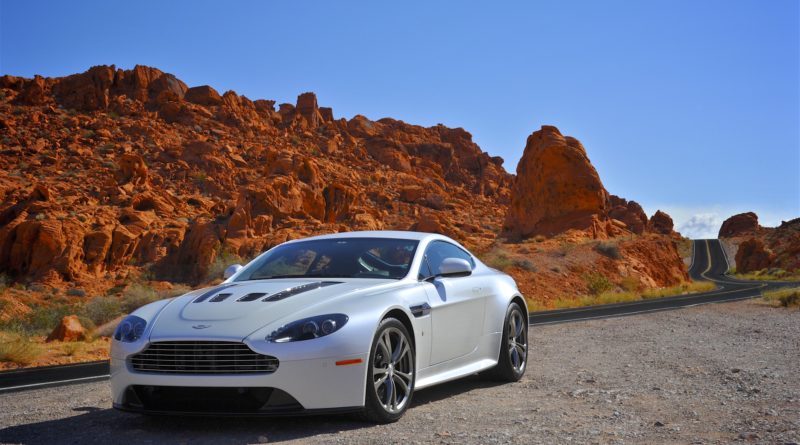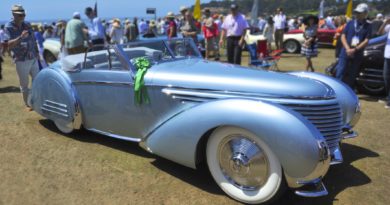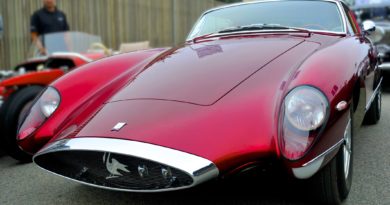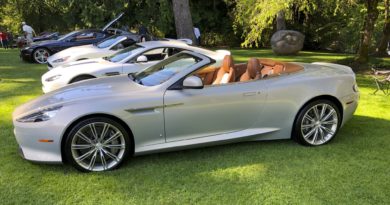The Aston Martin V12 Vantage
When I first drove this car at an Aston Martin event, I fell in love with it. Why did I like it so much? After some thought, I realized it’s a Jeckyl & Hyde. It is gorgeous, of course, but angry. And while it’s a modern GT, it certainly doesn’t coddle you. It has a wonderful 6-speed manual with a meaty, polished aluminum shifter, a broadband V12 that pulls hard through the rev limiter, and traditional dual rate springs with minimal traction control (and an off button, if you dare). It’s a seat-of-the-pants driver that demands you exercise your skills. It’s engaging, delightful; it wants to be a hotrod but is so much more than that. Matt Farah of Smoking Tire says it reminds him of the Shelby Cobra 427. Old school. Wild, untamed. Watch what you’re doing kind of wild. Yeah, that car.
While it’s trackable, it’s also tractable. Reliable, and with a surprisingly light clutch pedal, you can drive it around town. The only problem with that is you don’t want to – you want to find a twisty and put the pedal down.
The V12V is an analog car in a digital age. It’s undiluted – no turbos, no supercharger, no adjustable spring rates, no magnetic struts, minimal digital sensors. There’s a real clutch pedal. The steering is pure, direct, hydraulic. Modern materials – yes; Nanny state protections – no. It’s you and the machine. Your inputs create what manifests itself in the car’s performance. It’s a car you have to learn. And the satisfaction is glorious.
Aston Martin’s, particularly this one, are a bit of an enigma for most non-Brits. They are so beautiful and visually resolved, and so sumptuous on the inside, it is hard to imagine them being hard core driving machines – but this one definitely is.
While it’s rev limited to 190 MPH, it has a calculated top speed of 204 without it. Having blown right through 170 in this car like it was nothing, I can believe it.
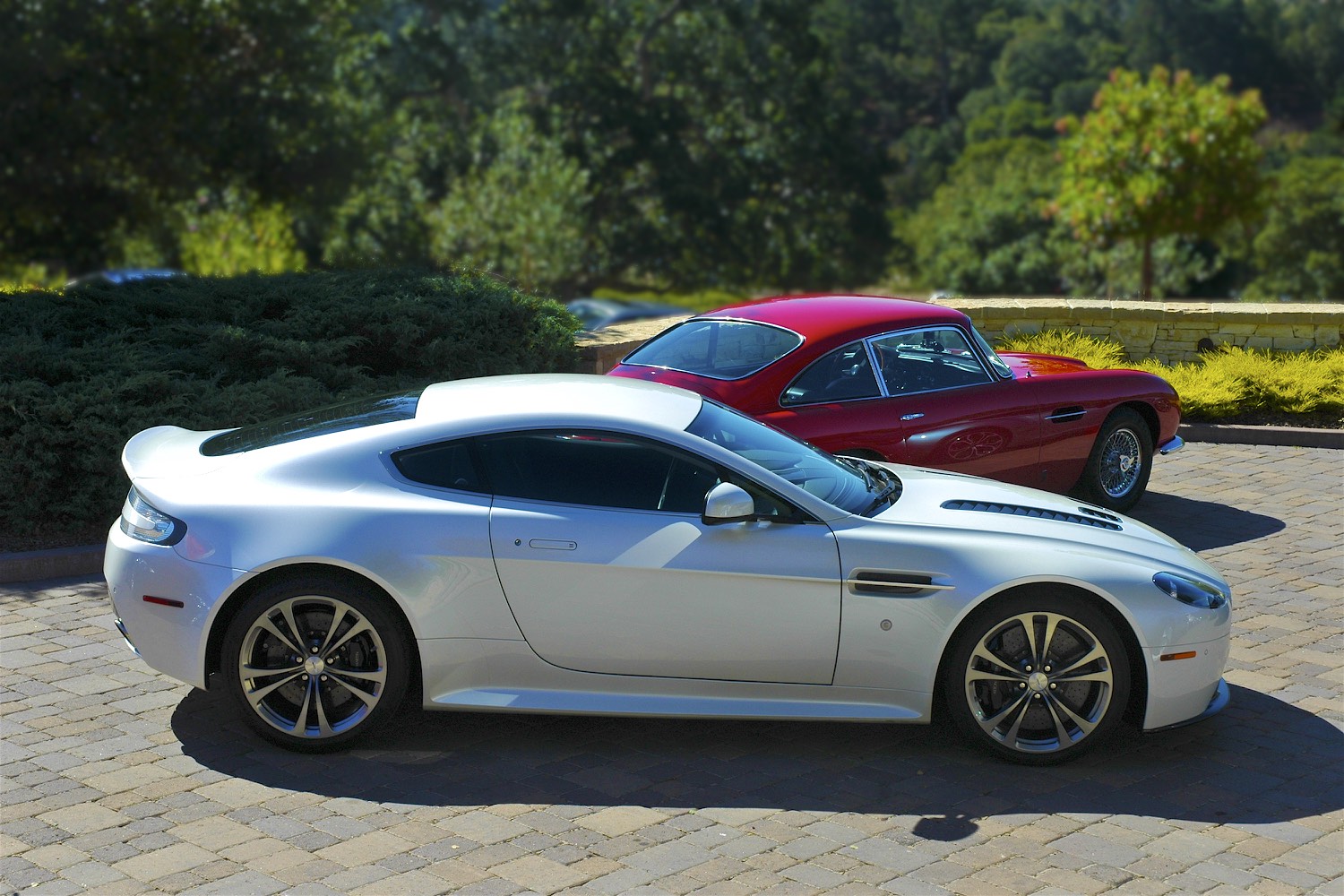
Richard Meaden from Vantage magazine had a few things to say about it: “In the case of the V12 Vantage (putting a big engine in a little car) actually resulted in something rather magical. …It was as unapologetic as it was irresistible… (and) an instant hit with true enthusiasts precisely because it was a car that required skill, commitment and self-control to truly master.”
“Adrian Newey of Red Bull racing fame also has an example in his garage and is a big fan. (Matt) Becker (once of Lotus) still concedes it’s a real thrill and a surprisingly well-rounded machine, while Stephen Archer and I moon at it like lovelorn teenagers. It’s a truly great car and a definitive Aston.”
Originally conceived by Ian Callum as a mid-engine sports car, the Vantage was re-styled by Henrik Fisker when CEO Ulrich Bez overruled Callum, saying economics dictated it follow the Aston VH platform for a front engine, rear drive set up. None of this is particularly surprising given Ulrich and Ian’s sometimes strained relationship.
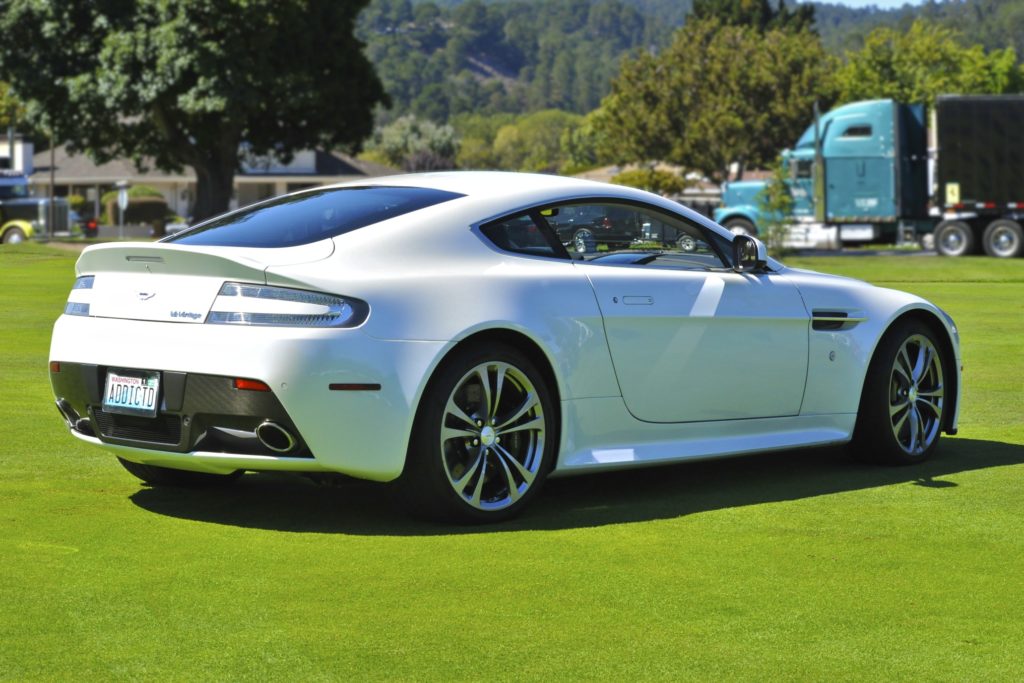
Already blisteringly fast, if you add an ECU program tweak & a Quicksilver exhaust you get even more torque and another 50 HP (to 560). Aston’s now venerable V12, conservatively rated for bulletproof reliability, was originally developed by Ford Research in the late 1990s for the DB7 utilizing both DuraTec V6 and Cosworth F1 racing technologies. As such, some denigrate its development by claiming it not much more than two Eco V6s stuck together. This is completely incorrect according to Anthony Musci, the principal Ford development engineer. It shares some of the concepts with the DuraTec engines, but the V12 is a completely unique design intended from the start to provide performance growth and racing capabilities. That has proven out with an outstanding race history and current variants in 2017 generating over 820 HP.
Ford’s ownership from 1994 to 2007 gave Aston Martin the resources to adopt modern manufacturing processes and to build a wholly-owned AM engine plant in Cologne, Germany. The forged engine blocks were supplied by Cosworth, but Aston did the rest. It took a single technician 20 hours to assemble an engine, and 10 more hours to dyno test and run each one in. Hand spraying, blocking and cutting means 50 more hours for paint. In total, it’s 200 manhours to build.
This one is number 1,039 of 1,199 made between 2009 and 2013, and one of only 207 built to US DOT specs. I fittingly first saw the Morning Frost White metallic pearlescent paint under streetlights at a pre-showing of the James Bond flick, “Skyfall.” I’m told the car was actually ordered by AM Americas and dealers vied for it as one of the last U.S. models built.
The car attends several shows a year where it always garners more than its share of attention. Aston’s design mantra is to produce “the most beautiful cars in the world,” and this car proves that. I often hear from people how the V12V is their favorite car in the world, or how this one, with it’s mesmerizing pearlescent, is their favorite car of the show. This white jewel has numerous show honors, graced the cover of Griot’s Garage Handbook #429, named Miss February in the Aston Martin Heritage Trust 2020 calendar, posted by Jalopnik.com as its ‘Weekend Wallpaper,’ and been featured as the only Aston in 2017’s “Seductive Supercars” exhibit at the LeMay Automotive Museum in Tacoma, WA.
Bedding carbon ceramic brakes can be something of an adventure. Vincent, the local Aston mechanic, was asked if these brakes needed any special break in. He kind of chuckled and said yes. Normally he does it for people, but he thought I should do this one. Ok, so I asked him for the specific instructions. Here’s what I got: brake from 30 to 0 MPH, 16 times. Drive for 2 miles at 50 MPH; then 50-6 MPH, 8 times. Drive for 2 miles at 50 MPH; next, 75-12 MPH, 12 times. Drive for 2 miles; last, 100-18 MPH, 8 times (!!). Pedal pressure should be hard and progress to full panic stop from the 50-6 sequence on. He said, “If you do it right, you should notice smoking and brake fade the last couple of cycles from 100.”
Gee, thanks Vincent. “And where am I supposed to do this without getting a nice ticket?” I asked.
He told me he did it on some 2-lane road out by Duvall. I told him I wasn’t too keen on that. “Oh, you’ll figure something out,” he laughed.
Well, he was right. Late one dry Sunday evening on Washington SR 599 in South Seattle l took care of business, all the while straining to see if any cops might be around.
With today’s eco-centric demands on the auto industry, it is unlikely another naturally aspirated, fully manual V12 car will ever be produced. As Jeremy Clarkson said after he first drove it, “Cars like this will soon be consigned to the history books. I have a horrible, dreadful feeling that what I’m driving here, is an ending.”
So it is in all probability the last of a breed. It’s everything an enthusiast could want – beautiful, rare, potent, full of soul with a snarling exhaust note, an impeccable V12 engine that mercilessly pulls into the great beyond, and eye-bulgingly magnificent carbon ceramic brakes. The interior is black tie tuxedo sharp with 6 wonderfully aromatic cowhides pulled together by a million stitches. Alcantara headliner, piano black wood and carbon fiber accents finish it off.
Once you drive it, it’s difficult envisioning life without it. Adrian Newey has called it ‘simply the best road car ever made.’ It’s just so special. There are others faster, more outrageous looking, better at the track, but the way this car’s bits come together to make the whole is a synthesis that rarely ever happens. Everything just blends into a seamless unfolding dream of a drive. And they only made 1199.
I’ve owned this car for eight years now. It’s still special and I can’t imagine a day when I will think otherwise. Am I smitten? Without a doubt. Do I care if other people don’t understand? I actually feel sorry for them if they don’t. They are missing one of the truly all-encompassing drives in recent memory. Luxurious, visceral, refined, and involving all in one.
As David Vivian (Vantage magazine, issue 2) relates, an Aston is “all about the ceremony, the theatre, that sense of occasion. Layers of experience. You look out the bedroom window and think ‘yeah, I’m going out in that tonight.’ That’s how it starts. And the anticipation has to be (and is) rewarded again and again, each step of the way.”
And that is just how it is.

